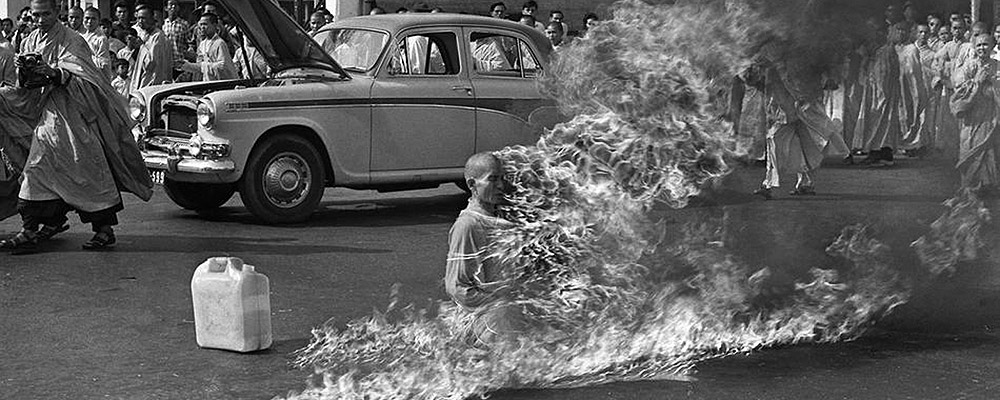ZEN MESTEREK ZEN MASTERS
« Zen főoldal
« vissza a Terebess Online nyitólapjára

Thích Quảng Đức 釋廣德 (1897-1963)
Thích Quảng Đức. (釋廣德) (1897–1963). Vietnamese monk who became
internationally known for his self-immolation (see SHESHEN) to protest the
oppression of Buddhism by the government of the partisan Catholic president Ngô
Đình Diệm. Thích Quảng Đức was born in Khánh Hòa province (Central
Vietnam) and his personal name was Lâm Văn Tức. He left home to become a
monk at the age of seven and received full ordination at the age of twenty.
Subsequently, he went to Mount Ninh Hòa to practice austerities and led the life
of a mendicant monk for five y ears. In 1932, he was invited to be a preceptor at
the Ninh Hòa branch of the An Nam Association of Buddhist Studies. In 1934, he
moved to South Vietnam, working with Buddhist communities in various
provinces for several y ears. He then traveled to Cambodia and lived there for
three y ears, devoting himself to rebuilding monasteries and study ing Pāli
literature. In 1953, the Nam Việt Association of Buddhist Studies invited him to be
the abbot of Phước Hòa Temple. The last temple he supervised was Quán Thê
Âm Temple in Gia Định. On June 11, 1963, when the tension between Buddhism
and the government reached a high point, he led a procession of more than one
thousand monks through the streets of Saigon. At a crossroad, he calmly sat down
in lotus posture, doused himself in gasoline, and set himself on fire. He is revered
by Vietnamese Buddhists, who refer to him as Bodhisattva Quảng Đức.
sheshen. (S. ātmaparity āga/dehadāna; T. rang gi lus y ongs su gtong ba / lus ky i
sby in pa; J. shashin; K. sasin 捨身). In Chinese, lit. “relinquishing the body,” viz.,
“self-immolation”; a whole complex of religiously motivated ty pes of suicide in
the MAHĀYĀNA tradition, of which “autocremation” (shaoshen) is best known
but which may also include suicide by drowning, starvation, feeding oneself to
wild animals, etc. (The Sanskrit ātmabhāvaparity āga means “giving up one’s
self,” as soldiers might for their country, and by extension an act of extreme
charity.) This practice is associated with the perfection of giving
(DĀNAPĀRAMITĀ) that occurs on the first BHŪMI, PRAMUDITĀ (joy ful), of
the bodhisattva path, where the bodhisattva learns to abandon every thing that is
most precious to him, including his wealth, his wife and family, and even his own
body. Self-immolation is a common trope in Indian Mahāy āna literature, where
this “gift of the body” (DEHADĀNA) is performed as an ultimate act of selfsacrifice.
One of best-known examples is BHAIṢAJYAGURURĀJA (Medicine
King) in the SADDHARMAPUṆḌARĪKASŪTRA, who pay s homage to the
buddhas by burning himself alive. Self-immolation goes back to at least the latefourth
century in Chinese Buddhism but is perhaps best known today through the
suicides of such Vietnamese monks as THÍCH QUẢNG ĐỨC (1897–1963),
whose autocremation in 1963 at his residence of THIÊN MỤ TỰ drew attention
to the persecution of Buddhists by the pro-Catholic Vietnamese government of
Ngô Đình Diệm. The legitimacy of the act of self-immolation was a matter of
continued debate within the Buddhist tradition, since suicide could be viewed as a
form of attachment or passion (RĀGA), viz., the attachment to “nonexistence”
(S. abhavarāga; C. wuy ou ai). But there were also vehement supporters of selfimmolation,
who saw it as the consummate expression of asceticism (see
DHUTAṄGA) and selflessness (ANĀTMAN). The Chinese term sheshen is used
interchangeably with the sy nony ms wangshen (to lose the body ) and y ishen (to
let go of the body ); an analogous Sanskrit term is svadehaparity āga (abandoning
the body).